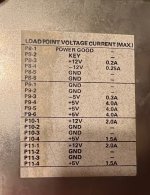Not that I dont trust you,, your site is pretty much the gold standard on these machines. ITs just that I find numbers from 110W to 130W and even more BS ones up to 300W on the XT PSU which I dont believe. Are there different variants in the XT's from early models to the later ones or 286 models?
Note that when I use "XT" in the context of the IBM 5160, you will see that I use "IBM XT" rather than "XT". I do that because I am aware from past threads that there are readers here who consider "XT" to include clones of the IBM XT.
It makes sense to me that you are writing of the IBM XT. However, you wrote "286 models", which to me suggests that you include the IBM 5162, a.k.a. XT model 286, as an IBM XT. I do not consider the XT model 286 to be an IBM XT - it is an AT-class computer.
Yes, we do not know exactly what is in the silver PSU case. For the IBM PC, it could be that some makers for IBM put in circuitry that is capable of sustained power delivery of more that 63W. For the IBM XT, it could be that some makers for IBM put in circuitry that is capable of sustained power delivery of more that 130W. Unless the PSU has the output rating/s marked on it, all we can go on is what IBM say.
This is mine, original to my machine and been working fine for over 35 years.
The photo does not show the output rating. It shows an input rating of "INPUT: 110V, 3A". One has to be careful with those. It is easy to think, 110V x 3A = 330W, and therefore this PSU is capable of supplying about 300W. The 3A is likely to be a
peak amperage figure for what the PSU consumes, not
directly related to the sustained power that the PSU can deliver.
My IBM 5153 is an example of the name-plated current figure being an approximate peak input figure.
I measured the average AC current consumption of my "100-250V~@0.95A" marked IBM 5153.
245 Vac
------------
My 5153002 with video input (a few lines of text) = 0.43 A
My 5153002 without video input (white screen) = 0.48 A
120 Vac
------------
My 5153002 with video input (a few lines of text) = 0.55 A
My 5153002 without video input (white screen) = 0.64 A
The average current consumption is about half of the "0.95A".
What is actually going on is shown below.








